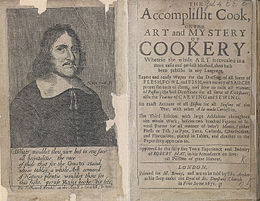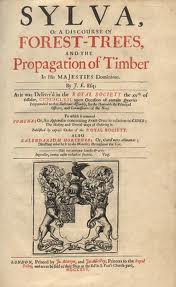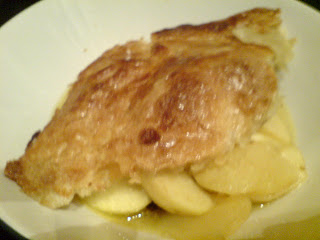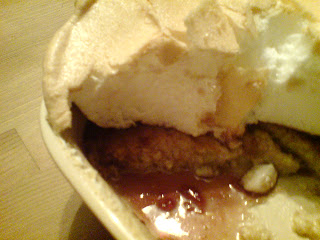It is always interesting to try a new food, and this 1660 recipe from The Accomplisht Cook by Robert May contains two.
The first is a capon, which is a castrated cockerel. Castration causes the capon to grow fat and large and to develop a different flavour to chicken. There are two ways to castrate, or caponise your cock: the first is to remove the testicles surgically, the other is to do it hormonally using oestrogen implants. You don’t them around very often these days, but a good butcher should be able to order you one. I got mine from Straub’s – there was one just sat there in the freezer section, bold as you like. If you want to caponise your own cockerel, click here for instructions!
The second new foodstuff is verjuice which is certainly not something you see much these days. Verjuice is made of the juice of either sour apples or sour grapes and was used as an acidulater; lemons were very pricey then, but there was no problem growing sour grapes and apples in Britain! It was particularly popular in the 16th and 17th centuries. I found the verjuice another of my favourites St Louis haunts, Global Foods Market, but I see you can also buy it online.

This recipe asks for the capon to be gently simmered just like the turkey with celery sauce I made last November. It is served with a bread sauce that is seasoned with the verjuice and some oyster liquor, though no oysters are actually used in the recipes themselves. I was hoping I could buy some liquor in jars just as you see clam liquor in the supermarkets. I am sure clam juice would be a good substitution, but as I am cooking the recipes as given, I must use oyster. (It turned out well in the end, as it gave me the perfect excuse to make some angels on horseback – look here for my recipe.)
Also served are some crunchy sippets, made from bread, and sugar peas in a buttery sauce. I was quite surprised that sugar peas were even around in the 17th century, I’ve always considered them a recent addition to our grocer’s shops and allotments.
There are 4 elements to this recipe are not particularly complicated, but they do require a little thought…
The Capon
Place a capon, breast down, in a large stockpot with its giblets.
Add water to just about cover the bird and add the stock herbs: thyme, rosemary, parsley and fennel; then add 2 or 3 blades of mace and season well with salt and pepper. Bring to a boil and simmer exceedingly gently until cooked – my 7 pound capon took about 1 ½ hours – the best way to tell it’s done is to spear the thickest part of the thigh and look for pink juices just you would do for a roast turkey or chicken. Remove the capon to a plate, cover it with foil and let it rest for 20 to 30 minutes. On no account throw away the delicious fennel-scented stock. Freeze it in batches and use as needed for soups, &c.
The Bread Sauce
Start getting the sauce ready around 30 minutes before you think the capon will be ready. Peel two onions and simmer them, covered, in water until they are tender and then blitz them in a processor or blender, or if you want to be old-school, pass them through a sieve or a mouli-legumes. Stir into the onions around four ounces of fresh breadcrumbs and a few ladlespoons of the capon stock so that you have a nice sauce. Use some oyster liquor and verjuice as well as some salt and pepper to season the sauce.
The Sippets
Sippets are fingers or triangles of bread either fried or baked and were very commonly served under meats to soak up the delicious juices. I made fingers with thickly sliced bread and baked them in a 180⁰C (350⁰F) oven until crisp and crunchy, around 20 minutes. These can be done in advance and warmed through in the oven if you like.
The Sugar Peas
The sugar peas – ‘cods’ – can be prepared whilst the capon is resting. When the cods be but young, string them and pick off the husks. Take 2 or 3 handfuls and but with ½ sweet butter, ¼ pint of water [this equalled 4 fluid ounces back in the day, rather than 5 as it does today in the UK], gross [black] pepper, salt, mace and oil. I used olive oil. Heat all the ingredients aside from the pods in a saucepan, add the pods, cover and stew until tender but with a little bite left in them.
Next, thicken the sauce with 3 or 4 egg yolks that have been beaten with 6 tablespoons of dry sherry (this is one of Jane’s substitutions, the original recipe used sack, a type of sweet ale).
Joint the capon and serve it on the sippets with the peas and their sauce poured over. Serve the bread sauce in a separate bowl or jug.
#335 Boiled Capon with Sugar Peas. After the success of the boiled turkey, I was looking forward to trying this new meat. I was a little disappointed; the meat wasn’t particularly flavourful and it was a little tough. That cockerel must have been doing a lot of strutting around, even without its testicles. As I ate my leftovers over next day or two, I did notice that the flavour of the meat did develop more – it was very turkey-like. The bread sauce and the peas were very nice however. I think if the capon was swapped for a chicken or turkey, this would be really good. 5.5/10.

























